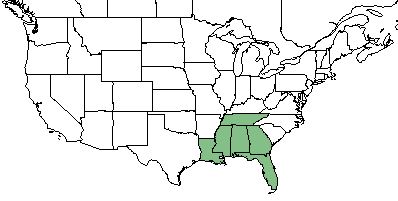Difference between revisions of "Gratiola floridana"
(→Conservation and Management) |
(→Conservation and Management) |
||
| Line 41: | Line 41: | ||
==Conservation and Management== | ==Conservation and Management== | ||
| − | It is considered endangered in the state of Tennessee but not in any other region, but ''G. floridana'' should be monitored in the communities for its infrequency <ref name= "USDA/>. | + | It is considered endangered in the state of Tennessee but not in any other region, but ''G. floridana'' should be monitored in the communities for its infrequency <ref name= "USDA"/>. |
==Cultivation and restoration== | ==Cultivation and restoration== | ||
Revision as of 16:49, 22 May 2018
| Gratiola floridana | |
|---|---|

| |
| Photo by the Atlas of Florida Plants Database | |
| Scientific classification | |
| Kingdom: | Plantae |
| Division: | Magnoliophyta - Flowering plants |
| Class: | Magnoliopsida - Dicots |
| Order: | Scrophulariales |
| Family: | Scrophulariaceae |
| Genus: | Gratiola |
| Species: | G. floridana |
| Binomial name | |
| Gratiola floridana Nutt. | |

| |
| Natural range of Gratiola floridana from USDA NRCS Plants Database. | |
Contents
Taxonomic Notes
Synonyms: none
Varieties: none
Description
Also known as the Florida hedgehyssop, G. floridana is a native annual forb that is a member of the Scrophulariaceae family [1].
Distribution
Ecology
Habitat
G. floridana can be found in spring runs, steam banks, and blackwater swamps [2].
Phenology
The species flowers in the month of March [3].
Conservation and Management
It is considered endangered in the state of Tennessee but not in any other region, but G. floridana should be monitored in the communities for its infrequency [1].
Cultivation and restoration
Photo Gallery
References and notes
- ↑ 1.0 1.1 USDA Plants Database URL: https://plants.usda.gov/core/profile?symbol=GRFL2
- ↑ Weakley, A. S. (2015). Flora of the Southern and Mid-Atlantic States. Chapel Hill, NC, University of North Carolina Herbarium.
- ↑ Panflora URL: http://www.gilnelson.com/PanFlora/